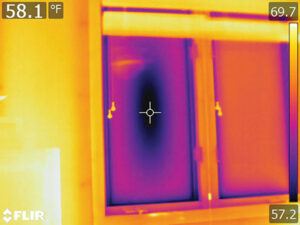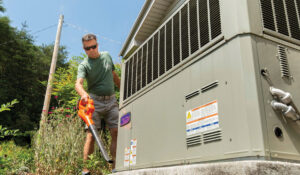There is a condition in the winter that drives some homeowners crazy – sweating windows! The colder the temperature outside, the worse it is. Droplets of water run down the glass onto the wood or vinyl sash, onto the window trim and down the wall. I have seen homeowners have a “towel changing schedule” to soak up the water before it gets onto their beautiful wood trim and cause discoloration or even wood rot. This is not a new or old home problem, or even a new or old window problem. And, it’s not the window manufacturer’s problem either.

“Well, whose fault is it,” you ask? “I just paid $17,000 for all new replacement windows with a 20 year guarantee. I didn’t have this problem before those windows were installed.”
The problem has nothing to do with the windows. Now you probably think I’m crazy, right. But stay with me and I will explain what is going on in the home to cause the windows to sweat.
In past articles I have mentioned that a good range of relative humidity (RH) in the home was 35 to 40 percent RH in the wintertime. What happens if the indoor humidity of your home creeps up to 50 – 60 percent RH or even more?
Let’s go back in time to your grade school science class when learning about “condensation.” When the combination of a cool surface temperature and high enough relative humidity meet the dew point, water droplets will form on almost any surface in the home. The R-value of most exterior walls in homes is R13 and the R-value of attics is usually R20 to R50. What is the R-value of your new $17,000 replacement windows? R3. We know the more R-value you have, the greater the resistance to heat flow, and the better the insulation. Then it stands to reason that your new windows would be the coldest surface in your home. However, this alone will not cause your windows to have condensation on them.
Actually, the amount of condensation on your windows in the winter is an excellent humidity gauge, if you know what to look for. When you have about one-half to one inch of condensation on the bottom of each pane of glass on a cold Illinois winter day then you are maintaining somewhere around 35 to 40 percent RH in your home, perfect! The greater the moisture content in the air of the home, the higher the moisture will be on the windows.
What can you do if the moisture in your home is too high? Turn on the bath and/or kitchen exhaust fans? In the winter, mechanical ventilation is a wonderful dehumidifier. For every cubic foot of air the fans pull out of the house, that same amount of air will find its way back in somewhere. When you bring in cold outside air and warm it up, the humidity goes down lowering the humidity level.
Excess condensation on windows is not a window problem at all. It tells me your home’s air infiltration is low (this a good thing) and you either have an excessive moisture source somewhere in the home and/or the people living there are not using the bath fans when they shower, or the exhaust fans are not ducted properly reducing the air flow of the exhaust fans. It’s usually poorly performing bath exhaust fans. Coming from

someone that measures the air flow of every bath exhaust fan when doing an energy audit, it’s usually a bad job of ducting exhaust fans. Rarely is the air flow of fans measured once installed. It’s not that difficult or expensive to do it correctly.
In older homes there is normally an operable window in every bathroom. That was the ventilation system for the home to remove the moisture and odor at the source. It’s kind of ironic that this article is about sweating windows, when homes built in the 60s and earlier simply cracked a window when showering to remove the moisture. A home built tight with the proper ventilation will not have these problems.









